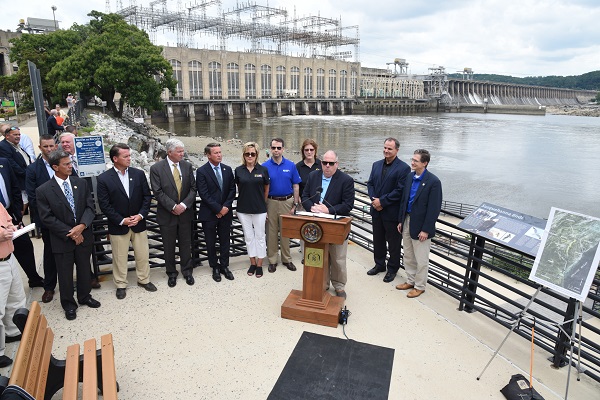The Maryland Environmental Service (MES) today announced that a notice of intent has been issued to award a contract to Northgate-Dutra Joint Venture (JV), for a demonstration project at the Conowingo Dam. The award is being issued as a result of the Request for Proposals (RFP) for the Conowingo Capacity Recovery and Innovative Reuse and Beneficial Use Pilot Project that was released in August 2017. The contractor was selected after a competitive procurement process.
Since campaigning for governor and from the earliest days of the administration, Governor Hogan has raised serious concerns about the long-ignored issue of sediment overflow and pollution from the Susquehanna River across the Conowingo Dam and into the Chesapeake Bay. Recent scientific reports confirm that the Conowingo Dam has reached capacity and can no longer fully stop pollution from entering the Bay.
To encourage collaboration and action, the administration has held two Conowingo Dam Summits with state and local officials, regional partners, and members of the scientific, research, and environmental advocacy communities to discuss solutions to the growing threat posed to the Chesapeake Bay by sediment flowing through the Dam.
“Today marks another important milestone in our progress to address critical environmental needs at the Conowingo Dam,” said Governor Larry Hogan. “The Conowingo Dam reservoir has reached capacity and is no longer able to trap sediment, which if allowed to flow downstream, will continue to substantially increase pollution, and negatively impact water quality in the Chesapeake Bay. This project is one element of our multi-prong approach to improving the health of the Chesapeake Bay and it is another great example of how we are using innovative approaches to solve the most pressing environmental challenges.”
“The Conowingo Dam challenge is one of the biggest environmental opportunities for the Bay and the Susquehanna in decades,” said Maryland Secretary of the Environment Ben Grumbles. “The pilot dredging and beneficial reuse project, the relicensing negotiations with Exelon for the dam’s continued operation and the midpoint checkup on Bay restoration plan progress are all converging for a cleaner river and Bay and they all depend on pollution prevention, collaboration, and innovation,” said Secretary Grumbles.
Led and managed by MES, at the direction of the Governor’s Chesapeake Bay Cabinet, the 25,000 cubic yard demonstration project will help the State determine a successful path forward for preventing sediment and nutrients from flowing down the Susquehanna River into the Chesapeake Bay, and for finding innovative reuses of the material.
“Today’s notice of intent of this award provides for the State of Maryland to move forward with an action plan to address the urgent challenges of the Conowingo Dam and Reservoir. We are ready and able to implement the innovative work that MES and Northgate-Dutra Joint Venture will accomplish together for the benefit of Maryland’s environment and residents,” said MES Director and CEO Roy McGrath.
Since its construction in 1928, the Conowingo Hydroelectric Dam has been trapping sediment from the Susquehanna River that affects the water quality of the Chesapeake Bay. According to a 2016 report – the Lower Susquehanna River Watershed Assessment Study – conducted by the U.S. Army Corps of Engineers, the dam has reached its trapping capacity, meaning that over time the same amount of pollution and sediment flowing into the Conowingo reservoir is also flowing out.
A technical evaluation committee made up of MES and consultant Anchor QEA, along with staff from Maryland Department of the Environment, Maryland Department of Planning, Maryland Department of Natural Resources, University of Maryland Center for Environmental Science, Susquehanna River Basin Commission and Exelon Corporation reviewed the technical and cost aspects of the proposals and scored each based on the firm’s ability to dredge and innovatively reuse 25,000 cubic yards of sediment. The awardee ranked highest in both of the key RFP metrics – technical and cost.



